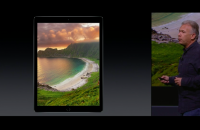
As a secondary device (or when my laptop is busy exporting), the iPad Pro does almost everything I need for work or play.
Steve Jobs, former CEO of Apple, announced the first iPad tablet on January 27, 2010. We didn’t know it at the time, but it was to usher in a new era of mobile computing, though one fraught with successes and failures.
Here’s a rundown of the most noteworthy tablets to take aim at the slate market over the last 10 years. Did you own any of these?
Apple iPad

The iPad, in all its forms and iterations, remains the market leader. The audience was stunned the day Steve Jobs announced the tablet, perhaps mostly by the slate’s price, which started at $499. True, it was an oversized iPhone with the same iOS platform and App Store, but Apple has worked hard over the years to differentiate it.
Apple’s tablet now comes in at least four different models in several different sizes, including Mini, Air, and Pro variants. The current iPad Pro line is as powerful as some laptops and can be used for creating content as well as consuming it. In fact, this article was written on an iPad Pro.
The iPad business may have fluctuated over the years, but Apple has enjoyed solid sales since introducing its newest slates. Most importantly, the iPad earned its own fork of iOS called iPadOS. The new platform gives developers more opportunity to target the tablet with rich apps.
The iPad, despite it faults and shortcomings, is still one of the most powerful mobile computers the planet has ever known.
Motorola Xoom

OMG, the Xoom. Motorola’s entry in the tablet space was the first real Android slate to offer some competition to the iPad. It was a disaster. The Xoom, which came in 8- and 10-inch models, ran Android 3 Honeycomb — a version of Android adjusted for the tablet form factor — and was one of the first tablets to offer cellular data. It was a mess.
The hardware was utilitarian at best. The real crime was the processor, an Nvidia Tegra 2. It was significantly underpowered and could hardly do anything without it make you wait eons. I bought one of these, but eventually used it only to serve as a mobile hotspot. It was a bad tablet and didn’t hurt the iPad at all. It later became the Xyboard.
Google Nexus 7

The Google Nexus 7 was the darling tablets of the Android world for a spell. It was sold in 2012 and 2013, with the latter variant standing as a role model for smaller slates.
With its 7-inch screen, the LTE-capable Nexus 7 was a perfect travel companion. It ran Android 4 Ice Cream Sandwich and acted more like an over-sized phone than a tablet, but it worked.
The tablet, made by Asus, was an exceptional piece of hardware, was affordable, and was a best-selling slate for years.
Microsoft Surface

The Surface is Microsoft’s convertible-cum-slate that is meant to act as a laptop most of the time, but can be a tablet when so desired. Now in its seventh generation, it’s clearly been a success. Mobile pros around the world have happily adapted the highly portable form factor. It starts at a respectable price point (~$800) and can be ratcheted up to full pro work machine if so desired.
The Surface Pro X is the latest variant and runs an ARM processor rather than an Intel X86 processor. The Surface is the most legit and successful iPad competitor to make it to — and remain in —the market.
Amazon Fire Tablet

Amazon’s Fire tablets have always been about consumption more than anything else. At this point, they all run a fork of Android and heavily favor Amazon-branded apps. They killer feature? The price. These tablets are incredibly affordable and are often sold for less than $100.
For any family invested in the Amazon ecosystem there’s no other real option. The Fire tablets are able to tap into Amazon’s e-book, music, and video services, which makes them natural entertainment fare. Together with the rock-bottom prices, you have an easy stocking stuffer come holiday season.
HP Touchpad
HP’s webOS-based tablet never actually made it to market. It was announced and then canned — along with webOS and all Palm products — just months later. While the device many have never surfaced, it became a cult hit. HP offered them via firesale and the webOS-based tablets were snapped up by tinkerers who were later able to install various updates to the platform before LG bought webOS from HP for use in TVs
BlackBerry Playbook
The BlackBerry Playbook was one of the biggest disasters in the history of the tablet space. Former BlackBerry CEOs Mike Lazaridis and Jim Balsillie didn’t want to put the BlackBerry Mobile Services business at risk and mandated that the Playbook rely on a nearby BlackBerry smartphone for core functions, including email, contacts, and more. It was just one of many missteps that hastened BlackBerry’s eventual demise.
What do you think? What were the best / worst tablets to make it to market, and which were true Apple iPad competitors?
More posts about iPad
from Android Authority https://ift.tt/2t4jdJr












No comments:
Post a Comment